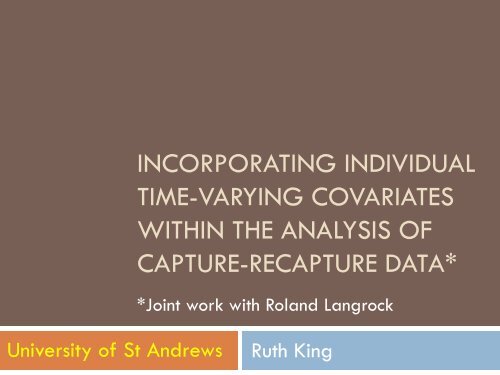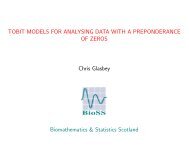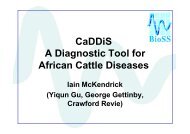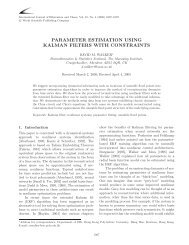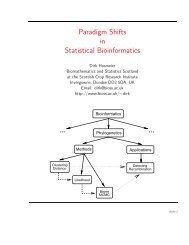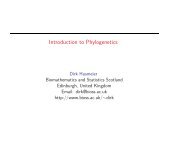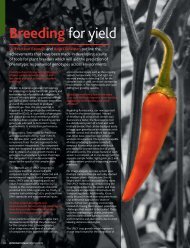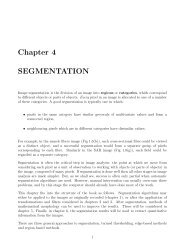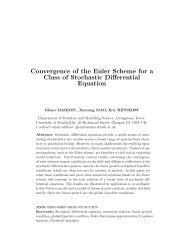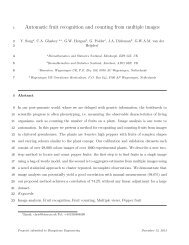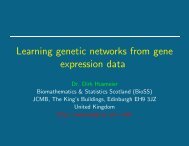Dr Ruth King: slides
Dr Ruth King: slides
Dr Ruth King: slides
You also want an ePaper? Increase the reach of your titles
YUMPU automatically turns print PDFs into web optimized ePapers that Google loves.
INCORPORATING INDIVIDUAL<br />
TIME-VARYING COVARIATES<br />
WITHIN THE ANALYSIS OF<br />
CAPTURE-RECAPTURE DATA*<br />
*Joint work with Roland Langrock<br />
University of St Andrews<br />
<strong>Ruth</strong> <strong>King</strong>
Introduction<br />
<br />
<br />
<br />
<br />
<br />
Motivating data – Soay sheep.<br />
Issues associated with continuous time-varying covariate<br />
information.<br />
Previous approaches:<br />
Trinomial method;<br />
Bayesian data augmentation.<br />
The use of (approximate) hidden Markov-type model.<br />
Discussion.
Data - Soay sheep †<br />
<br />
<br />
<br />
<br />
Soay sheep are uniquely marked via ear-tags as lambs.<br />
Each year observers go into the<br />
field and “record” all individuals<br />
that they see.<br />
Individuals can be “captured” or<br />
“resighted”.<br />
If an individual is captured, an associated weight may also be<br />
recorded.<br />
We consider data for 1633 females collected from 1986-<br />
2010 – there are a total of 6261 captures/resightings, 1230<br />
weights recorded and 1046 recoveries (of dead individuals).<br />
†<br />
Many thanks to Tim Coulson for the data
Capture-Recapture-Recovery (MRR)<br />
<br />
<br />
<br />
This type of data is often referred to as capture-recapturerecovery<br />
(or mark-recapture-recovery; MRR) data.<br />
MRR data are typically summarised in the form of the capture<br />
history of each individual observed in the study.<br />
An example of a capture history is:<br />
0 = unobserved;<br />
1 1 0 1 0 2<br />
1 = observed alive (either resighted or recaptured);<br />
2 = recovered dead.
Likelihood<br />
<br />
<br />
<br />
The corresponding likelihood is the product over each individual<br />
observed of the probability of their corresponding capture<br />
history, conditional on their initial capture.<br />
It is a function of survival (Á), recapture (p) and recovery (¸)<br />
probabilities.<br />
For example, for the previous capture history, the corresponding<br />
likelihood contribution is:<br />
1 1 0 1 0 2: Á 1 p 2 Á 2 (1-p 3 ) Á 3 p 4 Á 4 (1-p 5 ) (1-Á 5 ) ¸6
Individual time-varying covariates<br />
<br />
<br />
<br />
<br />
We are particularly interested in the relationship between<br />
weight (as a proxy for condition) of an individual and their<br />
associated survival.<br />
We specify the survival probabilities as a deterministic function<br />
of their weight (i.e. a time-varying individual covariate):<br />
logit Á it = ¯0 + ¯1 w it<br />
The corresponding likelihood is no longer available in closed<br />
form.<br />
For example consider the following history:<br />
1 1 0 1 0 2: Á 1 p 2 Á 2 (1-p 3 ) Á 3 p 4 Á 4 (1-p 5 ) (1-Á 5 ) ¸6
Individual time-varying covariates<br />
<br />
<br />
<br />
<br />
We are particularly interested in the relationship between<br />
weight (as a proxy for condition) of an individual and their<br />
associated survival.<br />
We specify the survival probabilities as a deterministic function<br />
of their weight (i.e. a time-varying individual covariate):<br />
logit Á it = ¯0 + ¯1 w it<br />
The corresponding likelihood is no longer available in closed<br />
form.<br />
For example consider the following history:<br />
1 1 0 1 0 2: Á 1 p 2 Á 2 (1-p 3 ) Á 3 p 4 Á 4 (1-p 5 ) (1-Á 5 ) ¸6<br />
Weight unobserved<br />
Survival probabilities “unknown”
Previous approaches<br />
<br />
<br />
In the presence of missing values, the likelihood is only<br />
expressible in the form of an analytically intractable integral<br />
(integrating over all missing covariate values).<br />
Two approaches are predominantly used in the analysis of<br />
time-varying individual covariates:<br />
Trinomial (or conditional) approach - the likelihood is constructed by<br />
conditioning on only the observed covariate values, resulting in a closed<br />
form (conditional) likelihood.<br />
Bayesian data augmentation approach - the missing covariate values<br />
are treated as parameters (or auxiliary variables) to be estimated and<br />
the joint posterior distribution is defined over the model parameters and<br />
auxiliary variables (use MCMC to obtain a sample from distribution).
Trinomial approach<br />
<br />
<br />
<br />
The “trinomial” (or conditional) approach was proposed by<br />
Catchpole, Morgan and Tavecchia (2008).<br />
The likelihood is constructed by conditioning on only the<br />
observed covariate values, resulting in a closed form<br />
(conditional) likelihood.<br />
Consider the capture history with associated covariate values:<br />
1 1 0 1 0 2<br />
Á 1 p 2 Á 2 (1-p 3 ) Á 3 p 4 Á 4 (1-p 5 ) (1-Á 5 ) ¸6<br />
0.41 ? ? 0.76 ? NA<br />
Á 1 (0.41) p 2 1– (Á 4 (0.76) p 5 + (1–Á 4 (0.76)) 5 )
Bayesian approach<br />
<br />
<br />
<br />
Data augmentation can be implemented within a Bayesian<br />
approach to deal with the missing data.<br />
The missing covariate values are treated as parameters (or<br />
auxiliary variables) and the joint posterior distribution is defined<br />
over the model parameters and auxiliary variables.<br />
MCMC can be used to sample from this posterior distribution<br />
and obtain estimates of the posterior summary statistics of<br />
interest.
New proposed approach<br />
<br />
<br />
<br />
<br />
The idea is to use a numerical approximation for the integration<br />
in the likelihood (the likelihood reduces to a product of 1-<br />
dimensional integrals for each missing covariate value).<br />
Assume first-order Markov process for the covariate process (i.e.<br />
weight at time t+1 is dependent on only the weight at time t).<br />
Approximate the integral associated with a missing covariate<br />
value by finely discretising the continuous space into a set of<br />
finite “bins” (e.g. 40 “bins”); and replace the integral with a<br />
summation (survival probabilities within a “bin” are assumed to<br />
be constant).<br />
This allows us to apply the efficient machinery of hidden Markov<br />
models for fast computation of the associated likelihood<br />
(assuming a Markov structure for covariate model).
0.0 0.2 0.4 0.6 0.8 1.0<br />
Discretisation<br />
Survival<br />
probability<br />
-4 -2 0 2 4<br />
Weight (normalised)
Approximate likelihood<br />
<br />
<br />
<br />
Consider the following capture history:<br />
1 1 0 1 0 2<br />
0.41 ? ? 0.76 ? NA<br />
Assume intervals [0.35,0.45),…,[0.75,0.85),…<br />
The (approximate) likelihood contribution is: x<br />
Á 1 (0.41)p 2 Á 2 (x 2 )(1-p 3 )Á 3 (x 3 )p 4 Á 4 (0.76)(1-p 5 )(1- Á 3 (x 5 ))¸6<br />
x 2 x 3 x 5<br />
x à 1 (0.41, x 2 ) à 2 (x 2 , x 3 ) à 3 (x 3 , 0.76) à 4 (0.76, x 5 ),<br />
<br />
where each summation is over the midpoints of the intervals.<br />
The transition probabilities à are completely defined by the<br />
underlying model for the covariate values specified on the<br />
continuous scale.
Simulation study (100 datasets)<br />
Intercept<br />
Slope<br />
p=0.95<br />
¸ =0.95<br />
p=0.9<br />
¸ =0.3<br />
p=0.3<br />
¸ =0.9<br />
p=0.3<br />
¸ =0.3<br />
Model<br />
95% CI<br />
width<br />
CI<br />
coverage<br />
95% CI<br />
width<br />
CI<br />
coverage<br />
Trinomial 1.39 0.96 0.08 0.94<br />
New approach 1.33 0.94 0.07 0.93<br />
Trinomial 1.69 0.95 0.12 0.95<br />
New approach 1.37 0.95 0.08 0.95<br />
Trinomial 3.08 0.97 0.14 0.97<br />
New approach 1.46 0.94 0.08 0.95<br />
Trinomial 3.73 0.98 0.11 0.95<br />
New approach 1.92 0.94 0.08 0.95
Results – survival<br />
Survival probabilities (as a function of weight)<br />
with associated 95% CIs.<br />
Lambs Yearlings Adults Senior<br />
Intercept -2.3 (-3.0, -1.7) -1.5 (-3.2, 0.1) -0.4 (-1.8, 1.0) -4.9 (-6.8, -3.1)<br />
Slope 0.21 (0.16, 0.27) 0.18 (0.09, 0.28) 0.12 (0.06, 0.19) 0.25 (0.17, 0.33)
Discussion<br />
<br />
<br />
<br />
The approximate hidden Markov-type model approach<br />
appears to work well.<br />
Model selection can be performed on both the dependence of<br />
the survival/recapture/recovery parameters (e.g. time/age<br />
dependence) and the covariate process model: e.g<br />
Time dependent p and ¸ - ¢ AIC = 0.<br />
Constant p and ¸ - ¢ AIC = 82.86<br />
Constant p and time dependent ¸ - ¢ AIC = 31.66.<br />
Further work includes refining this approach to improve the<br />
approximation.


